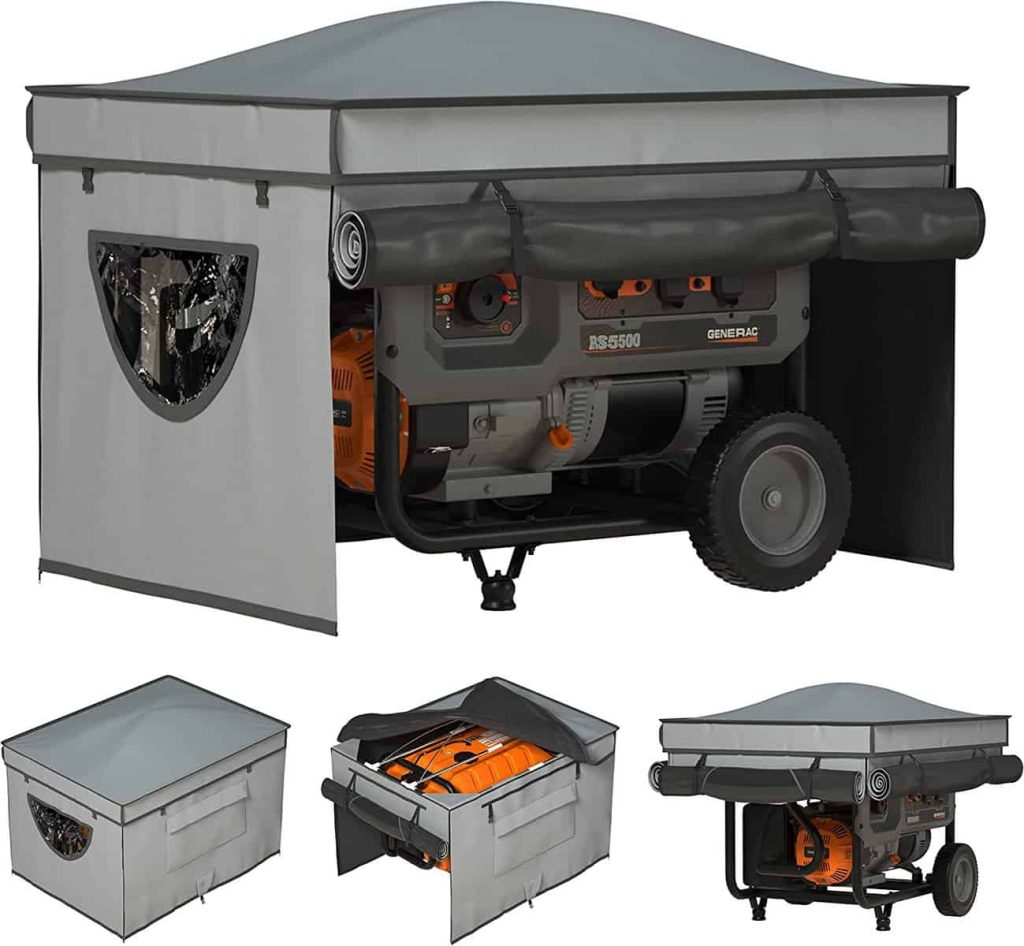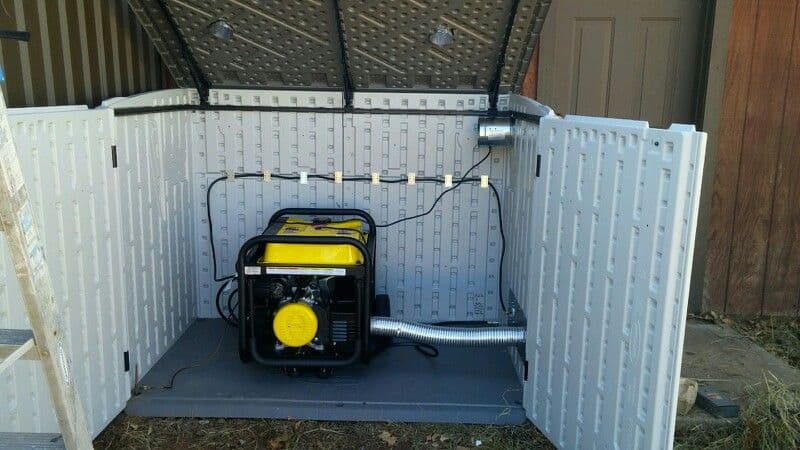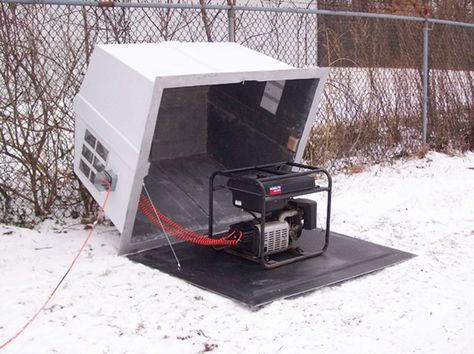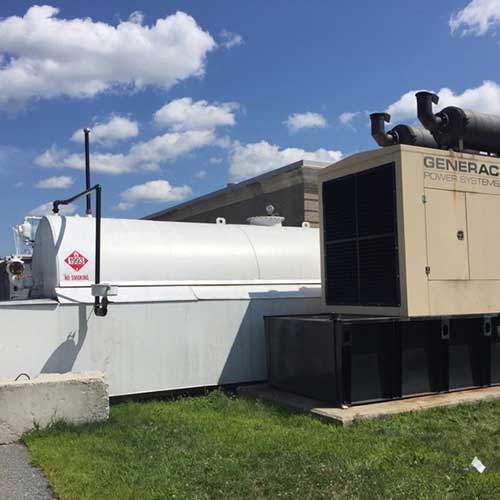Owning a portable generator is an excellent investment when power outages strike or low battery conditions occur. While these devices are typically robust and reliable improper storage can cause severe damage or even life threatening circumstances.
This is why understanding how to store your generator safely is critical.
All owners should honor correct procedures for storing their generators as doing so maximizes functionality while minimizing hazards associated with improper storage techniques.
The right practices keep these devices running efficiently for longer periods without compromising on safety measures needed within family settings or commercial environments alike – which we’ll discuss in detail shortly.

Choose The Right Location
Safely storing your portable generator is instrumental when it comes to maintaining top performance levels while also promoting longevity. Therefore selecting an appropriate location where the conditions are best suited for storage purposes is imperative.
The perfect site for a portable generator should be well ventilated with low humidity levels at all times. You cannot afford any compromise in this regard; thus always avoid positioning your equipment near open doors or windows or any vents that could allow fumes indoors.
In addition to selecting the correct location based on ventilation standards and humidity levels ensure you place your generator on solid ground such as concrete surfaces or gravel while observing spacing guidelines of at least three feet between walls and other surrounding objects.
Always take note of where you store your equipment to ensure easy accessibility in case of emergencies since time wasted attending to these issues could result in dire consequences later on due to fuel supply limitations which include propane tanks and gas cans within close proximity.
With these considerations taken into account when deciding how best to store your portable generator guarantee safety protocols observed diligently throughout the use cycle. Now that we’ve addressed storage concerns lets navigate through cleaning processes and inspection protocols with equal attention to detail.
Clean And Inspect The Generator
Now that you have installed your portable generator in the most suitable location possible lets prep it to ensure its optimal utilization- while keeping safety as our topmost priority. Regular cleaning inspections are absolutely crucial to maintain peak performance!
Start by carefully wiping down the exterior using either a damp cloth or sponge ensuring that everything is spic and span. While doing this remember to inspect for any loose screws or bolts as they can be a major hazard when operating at high speeds.
If you find any loose parts tighten them up with either your screwdriver or wrench before moving forward. Next check whether theres sufficient ventilation around the equipment so that it continues running without overheating; thus avoiding costly damages to both engine and other component failures down the line.Ensure Proper Ventilation
An important aspect to consider when keeping a portable generator in storage is ensuring it has proper ventilation. Failure to do so could lead to fatal accumulation of deadly carbon monoxide gas within closed spaces. Therefore make sure that you comply with all safety guidelines and provide ample air circulation for the safe running (or non operation) of your device.
Properly ventilating a space where you store a portable generator presents many advantages such as reducing harmful carbon monoxide build up while enabling optimal performance of equipment. Nonetheless adequate ventilation practices may also pose certain risks such as increased susceptibility to fire hazards in the presence of flammable material, potential noise pollution emanating from the generator or pest infestations attracted by an open area. One must carefully weigh the benefits and drawbacks when deciding on the necessary ventilation for their generator.
To guarantee secure storage for your portable generator, it’s essential to maintain a balance between keeping it safe and preventing potential hazards. Having acknowledged this, let’s now discuss how using a generator cover can provide protection for your equipment during its idle time.

Image Credit: pinterest
Use A Generator Cover
If you are looking to ensure optimum protection for your generator simply maintaining proper ventilation won’t suffice.
Thats where a generator cover can come in handy – this essential accessory can offer additional shielding to your machine from external elements like dust and water while also dampening noise levels and providing insulation against cold settings.
To reap the most out of this necessity you need to be sure that you’re purchasing the best quality cover possible which is made of high grade materials that can withstand prolonged exposure to harsh weather conditions. A tight fit is necessary to make sure air circulation is maintained without any disturbances. Covers with appropriate strapping or bungees will offer added durability during extreme weather challenges.
Investing in a good quality cover like this can keep your expensive equipment functioning at its finest for years on end. Now lets move on to adopting safe fuel storage measures for portable generators.

Image Credit: pinterest
Store Fuel Safely
If you’re looking to keep your portable generator functioning optimally over time safe fuel storage cannot be overlooked. Fortunately with just a few easy to follow steps you’ll soon have this aspect under control.
Firstly its important to store gasoline or diesel containers away from the generator and other flammable materials. This means keeping them out of direct sunlight and well clear of any ignition sources like open flames, cigarettes or sparks.
Ensuring that all containers are tightly sealed when not in use is equally important; regularly checking for leaks is also advisable.
To avoid any confusion between fuel types labelling each container with its contents is a smart precaution. Its also recommended that you keep all containers upright when storing them – this can help prevent spills from occurring inadvertently. Finally be sure to keep these containers safely out of reach of children and animals at all times.
By adhering to these straightforward storage protocols you can be confident that your portable generator will function smoothly and without incident in the long term.
So why wait? Take control of your safe fuel storage today for maximum generator performance tomorrow!

Image Credit: commtank
Use Fresh Fuel
When extreme weather strikes or power outages occur owning a portable generator can make all the difference between comfort and calamity. But ensuring your generators storage readiness takes more than just buying one – you also need to take some crucial steps to maintain its longevity.
And this begins with using fresh fuel. While it may appear obvious this measure isn’t always observed – yet its critical in preventing engine issues or carburetor obstructions arising from old fuel usage.
Fortunately gasoline stations nowadays offer ethanol free gas that meets the needs of small engines perfectly well. That makes getting hold of pristine fuel easier than ever before in history.
Alongside using clean fuel to guarantee proper function disconnecting spark plugs safely and securely prior to storage is also paramount in maintaining your generators performance over time.
Disconnect Spark Plugs
As we head towards colder weather seasons, maintaining your portable generator’s upkeep becomes an integral part of owning one. Disconnection of the spark plugs before storing it away during winter is an imperative step towards enhancing its durability and longevity overall. The good news is that this process does not require any challenging efforts whatsoever! Here are instructions:
1.On your portable generator’s side panel, find and locate the spark plug cover spot. 2.Utilize a flat head screwdriver or other tool recommendations to loosen up and unscrew the cover securely. 3.Gently pull out each spark plug with care taking note as they come out for ease in reinstallation later on down
4.Store each plug safely far from possible dirt or moistness.
Now that we’ve accomplished disconnecting our first critical task let’s get into utilizing battery tenders to keep our generators’ batteries healthy during off-seasons!
Use A Battery Tender
When it comes to protecting your portable generator and ensuring its long term viability one important step is utilizing a battery tender. Not only does this nifty tool keep your machines battery charged and prepared for use but it also helps preserve its overall condition over time.
Especially if you plan on storing your generator away from home for weeks or months at a time investing in a quality battery tender is key. Always leave your battery tender connected when not using your generator so that it remains powered up and ready to go whenever needed.
Additionally make sure there is ample ventilation around the machine when plugged in to avoid any potential overheating or malfunctions.
Remember to take extra caution whenever working with any powerful device like a portable generator — double check that all connectors are secured and follow best practices for safe usage.
With these measures in place along with effective utilization of a reliable battery tender storing and protecting your portable generator has never been easier or more stress free. Let’s move on to the next crucial step in safeguarding your portable generator: securely fastening it down.
Secure The Generator
When it comes to your generators safety and efficiency making sure that its stored securely connected correctly and fuelled appropriately is paramount. Here are three important steps that you need to follow for optimum safety and reliability:
Firstly store your generator in a safe place where it cannot be accessed by unauthorized people by locking it with a sturdy padlock or even chaining it with combination locks if need arises- do ensure that these locks are tested before usage for added peace of mind. Secondly check all connections between the generator unit itself and any external power sources meticulously before turning on its ignition; frayed cords/plugs/hoses can cause serious mishaps leading into fires as result so please replace immediately if there is an issue found pre operational process. And lastly- Always ensure that fuel levels are correct prior to using your device – this will prevent damages from occurring which could impact both longevity as well as operational stability during future usage scenarios too! If theres one thing you don’t want to neglect when operating a portable generator, its verifying the amount of fuel in its tank.
Running low on gas can wreak havoc on both your machine and personal health – leading to detrimental carbon monoxide exposure from an ill functioning exhaust system caused by inadequate pressure levels. So remember: always err on the side of caution and confirm that you have sufficient fuel prior to starting up.
By following these three fundamental protocols you’ll be able to confidently operate your generator without any worry or hassle. Prioritizing proper storage techniques is just one piece of the puzzle – lets now delve into why ongoing fuel level checks are crucial to maintaining optimal performance…

Image Credit: weathersafety
Regularly Check Fuel Levels
With your secure generator in place, ensuring it runs smoothly becomes top priority. Consistently monitoring its fuel levels not only guarantees optimal performance but also guarantees readiness for emergency situations.
It’s essential to never allow the tank’s content volume drop under one-quarter full as low levels can introduce air into the fuel lines thereby causing problems with engine function.
Furthermore, using stale gasoline within the generator promotes build-up which can cause problems; therefore replacing this with fresh gas before use is recommended practice.
Maintaining concise records of refills or fuel level checks is paramount in keeping your generator operating like clockwork.
Frequently Asked Questions
How Often Should I Check The Fuel Levels In My Generator?
If trouble free operation is what you’re after when using a generator then monitoring its gas supply should be top of mind for you! To keep things running like clockwork without any snags along the way my advice would be not neglecting routine checks on its gas consumption- do this after every use or if that isn’t possible once monthly- to guarantee a healthy gas supply for the machine.
By doing so you actively reduce the chances of any fuel related breakdowns.
Properly storing your generator in a secure place that is devoid of direct sunlight is also essential with this measure ensuring utmost efficiency whenever you need the tool.
What Type Of Cover Should I Use For My Generator?
Theres nothing better than having peace of mind knowing that your valuable possessions are well protected against natural elements such as extreme weather conditions.
Your generator is no exception! A trustworthy cover is crucial in shielding it from potential harm caused by rain or snow.
Opt for ones crafted using tough materials like polyester or vinyl – both known for their resistance against harsh weather conditions.
Ensure the cover is tailored according to your specific make and model so that it fits snugly over your machine without leaving any room for water leakage. Furthermore if possible look out for ventilated options! They support air circulation reducing heat buildup while keeping moisture away!
Where Is The Best Place To Store Fuel For My Generator?
A reliable generator can be an invaluable asset in times when power grids are down due to unforeseen circumstances such as natural disasters or equipment malfunctioning.
However one mustn’t forget about the importance of safe storage practices when it comes to gasoline – the primary source of energy for generators.
To ensure optimum levels of safety precautions select a cool and dry spot far away from any potential fire hazards to place your container filled with gasoline designated solely for generator use while ensuring its properly sealed as directed by regulatory bodies’ guidelines on gasoline storage containers’ construction material specifications.
Additionally keep the container out of reach from children or pets who may unknowingly tamper with it.
How Can I Ensure My Generator Is Properly Ventilated?
To prevent potential hazards when using your generator, proper ventilation is critical.
You can start by practicing caution with its placement – maintain at least ten feet between any walls or flammable objects nearby while keeping exhaust vents free from obstruction.
Consider elevating your unit atop a suitable platform and creating sufficient airflow for better results.
Investing in a carbon monoxide detector may prove wise since it will signal if there are unsafe gas levels around.
What Is The Best Way To Disconnect The Spark Plugs?
Taking care of your generators maintenance needs doesn’t have to feel intimidating or overwhelming – especially when it comes time to disengage those pesky but vital sparks! The proper technique entails shutting off the fuel valve first and foremost before removing all corresponding battery cables for optimal safety during operation procedures.
Using an appropriate sized socket wrench specifically designed for sparking purposes will then allow you successfully unscrew each component accurately without causing any further damage or complications down the line! As soon as each spark plug is individually removed be sure to store them all away in a secure location until they’re required again helping ensure your generator remains a safe and reliable source of power for years to come.
Conclusion
We all know how useful portable generators can be during emergency situations or outdoor activities- but what most people forget is that they require proper storage and maintenance for optimal performance.
A generator left neglected can result in costly repairs or even dangerous scenarios like fires! To avoid such mishaps take note of these basic steps: First off, monitor fuel levels regularly and keep them stored safely (away from flammable substances).
A cover isn’t just another accessory – it protects your machine against dust and other damaging elements! Good ventilation is also key when storing generators- ensure proper circulation at all times to prevent overheating or damage from condensation.
And lastly (but certainly not least) never forget to disconnect spark plugs when not using the generator- this may seem like common sense but many overlook this crucial step! Remembering these fundamental precautions will see that your generator operates without problems for many years ahead.





